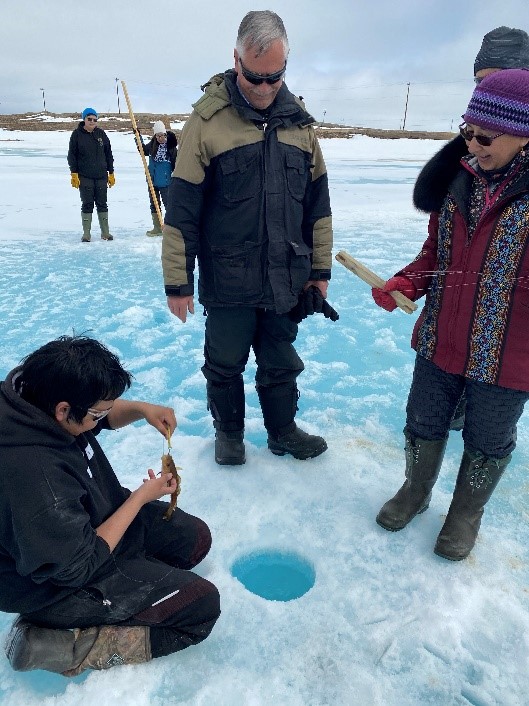2021-22 Departmental Results Report
Table of contents
- From the Minister
- From the President and CEO
- Results at a glance
- Results: what we achieved
- Spending and human resources
- Corporate information
- Supporting information on the program inventory
- Supplementary information tables
- Federal tax expenditures
- Organizational contact information
- Headquarters
- Appendix: definitions
- Endnotes
From the Minister

Polar Knowledge Canada’s (POLAR) 2021-22 Departmental Results Report provides parliamentarians and Canadians with an overview of the work the Government is undertaking to advance Canadian activity and leadership in polar science and knowledge. It outlines POLAR’s accomplishments over the past year in delivering programs and services for Canadians based on my mandate commitments as well as broader government priorities.
POLAR operates the Canadian High Arctic Research Station (CHARS) in Cambridge Bay, Nunavut, a hub for science, technology, and innovation in Canada’s North. CHARS enables a wide range of interdisciplinary scientific research, environmental monitoring initiatives, baseline data collection, and piloting technology projects. This work is critical in promoting robust Canadian Arctic ecosystems and communities, as well as to enhance economic opportunities, environmental stewardship, and the quality of life of Northerners.
Incorporating Indigenous knowledge and local knowledge with scientific knowledge is crucial for a sustainable approach to Canadian Arctic science and research. POLAR integrates these ways of knowing into its work through knowledge mobilization, outreach, and capacity-building activities for Northerners, with a special focus on empowering Indigenous youth. A key element in POLAR’s capacity-building efforts has been providing Northerners and Indigenous students with opportunities for training and participation in science and technology projects that are funded or led by POLAR.
POLAR also works in partnership with Indigenous organizations, governments, academic institutions, and other domestic and international research networks and, through a distinctions-based approach to setting research priorities provides better solutions to ensure a vibrant, prosperous and sustainable Arctic and northern region where people are striving, strong and safe. These actions support POLAR’s vision of a sustainable future guided by knowledge and collaboration, in which northern people are thriving, strong and safe.
I am honoured to have POLAR as part of my portfolio and pleased to provide this report on the work completed in the 2021-22 year.
The Honourable Dan Vandal, P.C., M.P., Minister of Northern Affairs, Minister Responsible for Prairies Economic Development Canada and Minister Responsible for the Canadian Northern Economic Development Agency
From the President and CEO
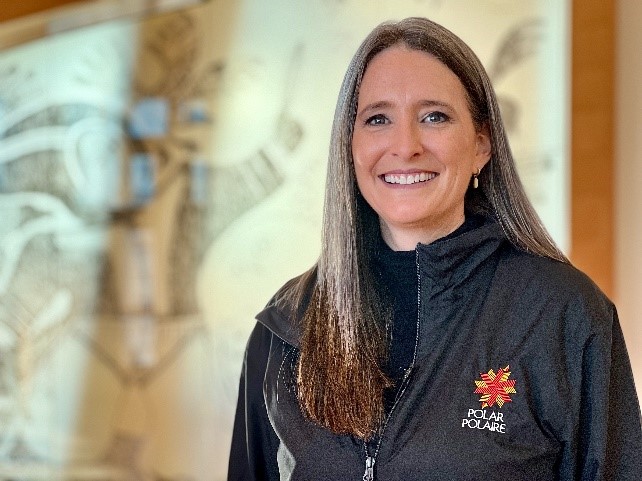
In 2021-22, Polar Knowledge Canada celebrated six years of research and engagement activities to advance knowledge of the polar regions and strengthen Canadian leadership in polar science and technology. Since joining POLAR as President and CEO in Fall 2020, I have observed how Canadian polar science and knowledge can promote better outcomes for Northerners, including how Indigenous youth play an integral role in the future in advancing Arctic research.
In 2021-22, POLAR continued to be impacted by pandemic-related restrictions, with research activities at the Canadian High Arctic Research Station gradually re-starting, we continued to develop and strengthen operational capabilities to ensure readiness as health restrictions continue to lift.
Prioritizing relationships with Indigenous partners, while establishing processes that enable more inclusive decision-making processes for Arctic research priorities and opportunities remains a key commitment for POLAR. This work is critical as the organization works towards its vision of “a sustainable future guided by knowledge and collaboration.”
POLAR continues to focus on promoting Nunavut Inuit representation in the Government of Canada, in accordance with Article 23 of the Nunavut Agreement. In 2021-22, POLAR continued to implement its Inuit Employment Plan and increased Inuit representation within its workforce, while advancing the Government of Canada’s aim to be an employer of choice in Canada’s North.
POLAR will continue to provide leadership in Arctic research through the creation and mobilization of polar science and technology, northern engagement, and by addressing the challenges of our dynamic polar regions.
I am pleased to present POLAR’s 2021-22 Departmental Results Report.
Jennifer C. Hubbard, President and CEO, Polar Knowledge Canada
Results at a glance
June 2021 was POLAR’s sixth year of operation. POLAR is a relatively small organization with a mandate to advance Canada’s leadership in polar science and technology and establish CHARS as a hub for scientific research in Canada’s North.
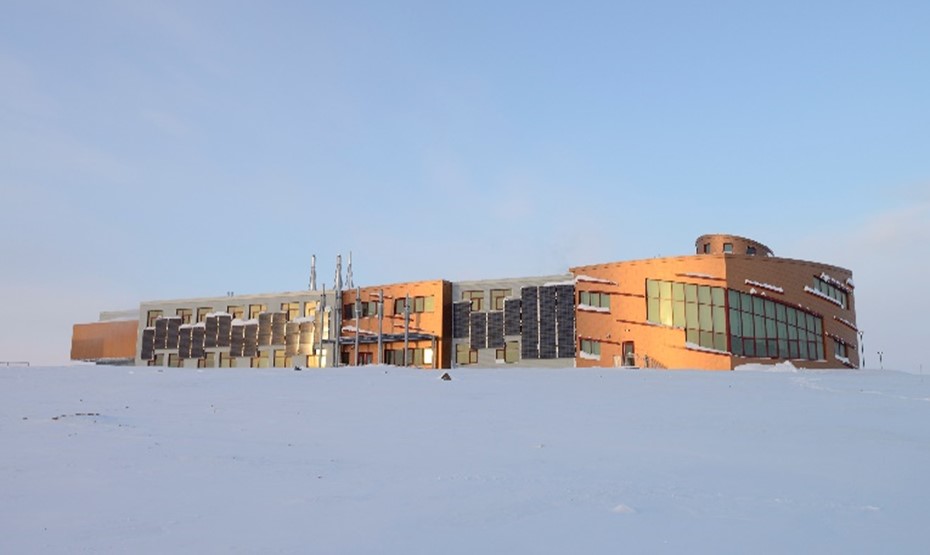
The Main Research Building of the Canadian High Arctic Research Station (CHARS) includes research labs, centres for technology development and knowledge sharing, office space, and spaces for teaching, training, and community engagement. Photo: A. Fradkin
In 2021-22, POLAR’s Arctic research activities continued to be affected by the COVID-19 pandemic with limited operations at CHARS during the 2021-22 field season. These public health measures limited visiting researchers from conducting in-person research activities, such as field sampling and surveys, which typically are conducted at CHARS. Despite these challenges, POLAR staff and collaborators were able to advance research and engagement activities virtually throughout the year. POLAR’s in-house team of researchers provided support to many research teams unable to travel to Nunavut by collecting samples and carrying out monitoring activities.
POLAR continued to work closely with Indigenous partners in polar science, research and knowledge dissemination, ensuring that Indigenous knowledge informs its policy-development, research priorities and decision-making. In 2021-22, POLAR co-led with Inuit Tapiriit Kanatami (ITK), United Kingdom Research and Innovation, the National Research Council of Canada, Parks Canada Agency and Fonds de recherche du Québec the development of a new Memorandum of Understanding to support the implementation of a collaboration international Arctic Region Research Programme. The Canada-Inuit Nunangat-United Kingdom (CINUK) will support Inuit self-determination in research by establishing programme research priorities, supporting capacity building among Inuit, co-developing calls for proposals, establishing a joint proposal selection process, ensuring the ethical conduct of research.

The Canadian High Arctic Research Station Knowledge Sharing Centre is a space where Inuit and scientific knowledge holders can meet and exchange perspectives and knowledge. This multi-purpose room can accommodate presentations and gatherings such as educational or community events. Photo: A. Fradkin
In 2021-22, POLAR also supported polar science and knowledge agenda through its operation of CHARS, external funding programs, and in-house science activities. POLAR fulfilled these priorities in the following ways:
- POLAR promoted environmental security in the North through increased scientific knowledge-creation and mobilization. This was facilitated through research collaborations, including a series of two-way knowledge exchange webinars;
- POLAR supported meaningful knowledge-creation and mobilization of information for evidence-based decision making by funding research on key topics of northern relevance; and
- POLAR incorporated Indigenous knowledge in its knowledge creation activities through engagements with Indigenous knowledge holders via virtual workshops and speakers’ series.
To maintain the ongoing inclusion of Indigenous knowledge and local knowledge in its activities alongside enhanced economic opportunities for Northerners, POLAR continued to implement its Inuit Employment Plan. Since 2019, this has contributed to a 19% increase in Inuit representation within POLAR’s Nunavut-based workforce. POLAR also promoted scientific education for Northern youth and students through a series of Science, Technology, Engineering and Mathematics (STEM) workshops.
For more information on POLAR’s plans, priorities and results achieved, please see the “Results: what we achieved” section of this report.
Results: what we achieved
Core responsibilities
Polar Science and Knowledge
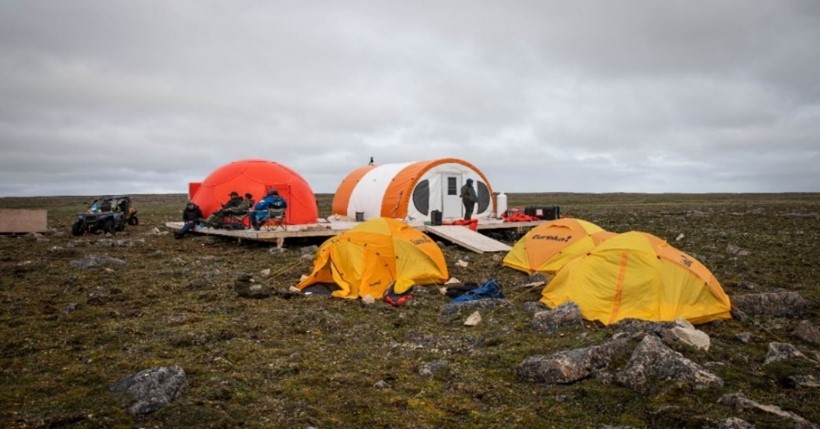
POLAR's Greiner Lake field research camp, located a short distance from Cambridge Bay
Description: Polar Knowledge Canada is Canada’s polar science agency operating out of the world-class Canadian High Arctic Research Station campus in Cambridge Bay, Nunavut. Polar Knowledge Canada performs and publishes multi-disciplinary polar research. Through our grants and contributions program, we fund external partners such as academia, northern communities and organizations who conduct research and related projects. Polar Knowledge Canada aims to include Indigenous and local knowledge wherever possible, and increase domestic and international research coordination and collaboration by leveraging resources with partners. Through workshops, conferences, social media, and other tools, Polar Knowledge Canada shares and promotes the exchange of knowledge across polar scientific and policy communities and the general public. Throughout all of its core activities, Polar Knowledge Canada aims to fund and train the next generation of polar research personnel, with a focus on northern youth.
Results
The following is a summary of the key activities associated with POLAR’s Results Framework:
Canada’s polar science and technology research is publicly available and being appliedThe polar science and technology research that is performed at the CHARS campus will be publicly available and shared within Canada and internationally through a wide range of publications, events, meetings and other means. |
|
For 2021-22, POLAR continued communicating and promoting polar research, enhancing research collaboration and producing research that is accessible to communities, researchers and all Canadians. Additionally, the organization sought to increase meaningful knowledge-creation that incorporates Indigenous knowledge and supports evidence-based decision making. POLAR achieved this goal by creating accessible and relevant knowledge products that were informed by Indigenous knowledge and local knowledge and disseminated to Northern communities. Results
|
Canada’s Arctic science includes Indigenous and local knowledgePOLAR will ensure that Indigenous and local knowledge is incorporated into the research that it performs and funds and will provide opportunities to advance Inuit employment and training in science, policy and administrative positions which will support POLAR in meeting the Government of Canada’s Inuit employment obligations under Article 23 of the Nunavut Agreement. |
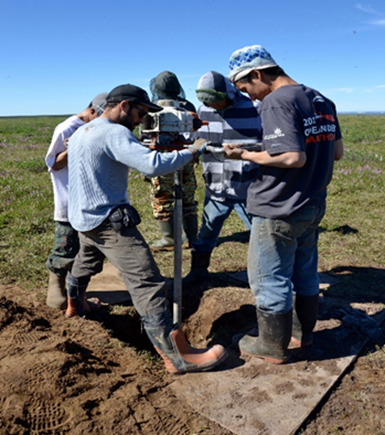
Researchers and community members taking a sample of permafrost near Kugluktuk, Nunavut, for a research on permafrost degradation that is damaging a local all-terrain vehicle trail. The trail links the community to important hunting and fishing areas. POLAR is a partner in this project. For 2021-22, POLAR conducted and funded projects that prioritized and included both Indigenous knowledge and local knowledge. In addition, the organization fostered proportional representation of Inuit employees in its ranks by continuing to implement its Inuit Employment Plan. POLAR sustained the transfer of technology skills, training and employment to Indigenous community members and staff through intramural research projects, community outreach and engagement, and knowledge management and mobilization activities. Overall, POLAR successfully promoted this goal as researchers consistently engaged with and included Indigenous knowledge holders in their knowledge creation and mobilization activities. Research operations during the COVID-19 pandemic was possible thanks to the close collaboration that POLAR researchers have built with community organizations, and through the employment and training of local project coordinators and community researchers. Moreover, POLAR engaged in skills transfer in Northern communities and continued to introduce measures to support the implementation of the Inuit Employment Plan. Results
|
Canada fosters domestic and international knowledge exchange and partnerships in polar science and technologyOperating and maintaining the CHARS campus as a world-class centre for polar science will allow POLAR to strengthen and expand national and international research collaborations and, in turn, gain knowledge and expertise to address regional and circumpolar challenges. |
|
For 2021-22, POLAR built upon its national and international polar science partnerships and continued collaborating with other federal departments, and Indigenous organizations to promote government priorities. POLAR also enhanced access to research infrastructure and expertise across the North, both domestically and internationally. Although the COVID-19 pandemic hindered planned international work POLAR continued to advance its knowledge and research priorities by pursuing partnerships with researchers, Indigenous organizations and other federal, provincial and territorial partners across virtual networks. Results
|
The next generation of Canadian polar researchers is developedPOLAR’s Grants and Contributions program and the CHARS campus will continue to support students in technical, science and research programs at colleges and universities. POLAR has specific initiatives delivered via the CHARS campus to encourage youth engagement, including science camps for local youth, summer employment, casual hires, and student placements. POLAR also has early-career researcher exchange programs to build a base of early career polar researchers. |
|
In 2021-22, POLAR continued to promote interest in polar science and technology opportunities by providing support to external partners for projects, and capacity-building initiatives for early career researchers. POLAR also continued to develop youth interest in polar science, research and technology through programming, engaging youth in science-based activities, and collaborating with partners on youth-targeted activities. POLAR was successful in supporting research initiatives within Canadian post-secondary institutions and promoting science education opportunities for Northern students. Results
|
Gender-based analysis PlusPOLAR’s Inuit Employment Plan 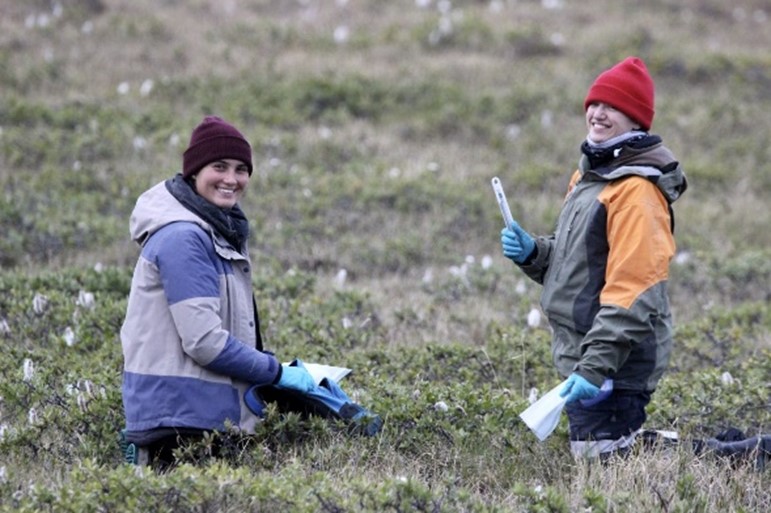
POLAR researchers Ashley Crosby (left) and Rachel Mandel (right) collaborated with the Canadian Museum of Nature to conduct studies on lemmings at Long Point, Nunavut Inuit occupied 46% of the encumbered positions at the Canadian High Arctic Research Station in Cambridge Bay, Nunavut as of March 31, 2022, and women accounted for 63% of Inuit Employees at CHARS. Inuit staff at POLAR are predominantly young and in recent years occupy an increasing number of entry- and mid-intermediate and senior level positions in Cambridge Bay, Nunavut, with 28% of Inuit employees occupying positions higher than entry-level. Administrative roles at CHARS are primarily occupied by Inuit, with 100% of these positions being represented by Inuit employees. With further implementation of the Inuit Employment Plan, there has been increasing representation of Nunavut Inuit in Technical and Operational roles in recent years, with Inuit representing 50% in these roles at CHARS, as well an increase in representation in management, with 17% of Nunavut-based management positions occupied by Inuit employees. However, work is still required to develop, recruit and engage Nunavut Inuit in scientific positions at CHARS including with the establishment in 2021-22 of a whole-of-government working group co-led by POLAR to increase the representation of Inuit in science-based positions. POLAR will continue to focus on increasing Inuit representation in scientific roles, and develop recruitment, development and retention strategies. POLAR also supported Inuit staff in pursuing post-secondary education, including in polar science fields, through the Pilimmaksaivik Education Support Fund. These efforts will support increasing representation of Inuit in mid-level and senior roles at POLAR and within the Government of Canada more broadly in years to come. |
United Nations 2030 Agenda for Sustainable Development and the Sustainable Development Goals
In 2021-22, POLAR supported Canada’s efforts to implement the United Nations’ 2030 Agenda for Sustainable Development by contributing to several of its Sustainable Development Goals (SDGs). In line with the vision set out by Canada’s 2030 Agenda National Strategy, POLAR recognizes that integrating these goals into its own work brings us a step closer towards improved sustainability, peace, inclusivity, and prosperity across Canada and the North.
In support of SDG 10 — Reduced Inequalities — POLAR aimed to increase Inuit representation within its ranks through its IEP. In accordance with Article 23 of the Nunavut Agreement, this Plan aims to increase Inuit employment in government to a representative level within all occupational groupings and levels in Nunavut. With the help of the IEP, Inuit representation in POLAR’s Nunavut based positions increased from 33% in June 2019 to 46% in March 2022, and representation in senior level and management positions has increased by 17% throughout the same period.
Advancing this overarching goal simultaneously contributed to SDG 8— Decent Work and Economic Growth, and SDG 11— Sustainable Cities and Communities, as increased access to employment in the North is a pathway to economic growth, sustainable communities, and improved infrastructure in the region. Related to this, POLAR advanced SDG 5 – Gender Equality by promoting gender equality in its recruitment efforts to ensure that the organization is representative of the Canadian population at large.
Results-based innovations2
As POLAR continues to mature as an organization, it is taking opportunities to reflect on ways to strengthen program outcomes through results-based innovations. While POLAR had not identified opportunities for results-based innovations related to the achievement of planned results associated with its “Polar Science and Knowledge” core responsibility this fiscal year, POLAR continues to find new ways to support its mandate. Efforts are being made to advance co-development and to improve to the consideration of First Nations, Inuit and Métis unique realities in all aspects of POLAR’s work. Where possible, POLAR leverages lessons learned from results-based innovations completed by other federal organizations with similar mandates and responsibilities.
Key risk(s)
POLAR has identified key risks to the achievement of results related to its core responsibility. These risks and measures to mitigate them are as follows:
Relationship and Reputational Risks – Much of POLAR’s operations and planned activities rely on collaboration and partnerships with other federal organizations, northern and Indigenous organizations and communities, and academia. These relationships include specific obligations outlined in treaties and self-government agreements; signed memoranda of understanding with Indigenous organizations; service agreements with other federal organizations; and others.
There is a risk that POLAR will be unable to complete planned activities due to internal capacity challenges or dependency on inputs from other organizations over which POLAR has limited control. As POLAR prepares to take over the custodianship of Canadian High Arctic Research Station, this includes the risk of being unable to fully operationalize the research station without adequate long-term funding. Should this risk materialize, important partners, particularly Indigenous organizations and communities, may perceive these delays as POLAR not fulfilling its commitments.
POLAR will mitigate these relationships and reputational risks by:
- Involving and supporting community participation early, and in every stage of projects;
- communicating POLAR’s commitments under memoranda of understanding with Indigenous partners, and taking meaningful action to implement these commitments;
- developing a multi-year Real Property Strategy, and defining and seeking long-term baseline funding to fully operationalize CHARS infrastructure; and
- addressing internal capacity challenges through timely recruitment including the ongoing implementation of its Inuit Employment Plan to attract, develop and retain talent.
Pandemic-Related Risks – In 2021-22, travel-related restrictions and other pandemic health and safety measures impacted POLAR’s planned activities, which hindered the 2021-22 field season and resulted in limited public access to CHARS and its facilities.
However, POLAR continues to mitigate this risk by:
- Supporting the implementation of projects and initiatives, such as knowledge management and engagement activities and events, by developing contingency measures, such as alternative program delivery options including virtual online seminars and workshops;
- engaging local expertise and experience (e.g., Hunters and Trappers Organization, Northern residents) to support to POLAR’s activities (such as performing ongoing monitoring of changes in the environment); and
- updating partners and stakeholders as disruptions affect program initiatives, commitments and planned results.
Results achieved
The following table shows, for Polar Science and Knowledge the results achieved, the performance indicators, the targets and the target dates for 2021–22, and the actual results for the three most recent fiscal years for which actual results are available.
| Departmental results | Performance indicators | Target | Date to achieve target | 2019–20 actual results | 2020–21 actual results | 2021–22 actual results |
|---|---|---|---|---|---|---|
| Canada’s polar science and technology research is publicly available and being applied | Percentage of research publications led or supported by Polar Knowledge Canada that are available online to the Canadian public | At least 30% | March 2025 | 61% | 60% | 83% |
| Number of citations of research led or supported by Polar Knowledge Canada | At least 100 | March 2025 | 338 | 439 | 91 | |
| Canada’s Arctic science includes Indigenous and local knowledge | Percentage of Arctic research projects led or supported by Polar Knowledge Canada that include Indigenous or local knowledge | At least 90% | March 2025 | 76% | 94% | 47% |
| Percentage of Arctic projects led or supported by Polar Knowledge Canada that involve Northerners | At least 90% | March 2025 | 67% | 100% | 69% | |
| Canada fosters domestic and international knowledge exchange and partnerships in polar science | Number of knowledge exchange activities or initiatives led or supported by Polar Knowledge Canada | At least 100 | March 2025 | 348 | 344 | 217 |
| Percentage of leveraged investment by Polar Knowledge Canada- supported projects | At least 100% | March 2025 | 38% | 48% | 66% | |
| Percentage of projects led by Polar Knowledge Canada that involve external partners | At least 75% | March 2025 | 78% | 60% | 45% | |
| The next generation of Canadian polar researchers is developed | Percentage of Polar Knowledge Canada-led or supported projects that involve youth or early career researchers | At least 80% | March 2025 | Data not available for these fiscal years as this indicator had not yet been established at that time. | 100% | 62% |
The difference between POLAR’s established targets and the 2021-22 actual results is attributed in part to the COVID-19 pandemic which resulted in travel restrictions, limiting the organization from fully completing its planned commitments and prevented visiting researchers from conducting in-person research activities, such as field sampling and surveys.
Financial, human resources and performance information for POLAR’s Program Inventory is available in GC InfoBase.
Budgetary financial resources (dollars) – Core Responsibility
The following table shows planned spending for 2021–22, as well as actual spending for that year to fulfill the Polar Science and Knowledge Core Responsibility.
| 2021–22 Main Estimates | 2021–22 planned spending | 2021–22 total authorities available for use | 2021–22 actual spending (authorities used) | 2021–22 difference (actual spending minus planned spending) |
|---|---|---|---|---|
| 16,105,186 | 16,105,186 | 16,105,186 | 13,810,911 | 2,294,275 |
The difference in planned versus actual spending ($2.3 million) in 2021-22 is largely attributable to project implementation delays related to the pandemic. Although some core program activities resumed following the relaxing of the pandemic protocols related to COVID-19, it remained well below the pre-pandemic operational level. A portion of the unused funding is expected to be brought forward in 2022-23.
Financial, human resources and performance information for POLAR’s Program Inventory is available in GC InfoBase.
Human resources (full-time equivalents) – Core Responsibility
The following table shows, in full-time equivalents the human resources the department needed to fulfill the Polar Science and Knowledge Core Responsibility for 2021–22.
| 2021–22 planned full-time equivalents | 2021–22 actual full-time equivalents | 2021–22 difference (actual full-time equivalents minus planned full-time equivalents) |
|---|---|---|
| 41 | 31 | (10) |
The variance of 10 between 2021–22 actual full-time equivalents (31) and 2021–22 planned full-time equivalents (41) can be explained by attrition and a limited pool of qualified candidates. Currently, POLAR is actively working to increase the number of full-time equivalents within this core responsibility.
Financial, human resources and performance information for POLAR’s Program Inventory is available in GC InfoBase.
Internal services
Description
Internal Services are those groups of related activities and resources that the federal government considers to be services in support of programs and/or required to meet corporate obligations of an organization. Internal Services refers to the activities and resources of the 10 distinct service categories that support program delivery in the organization, regardless of the Internal Services delivery model in a department. The 10 service categories are:
- Acquisition Management Services
- Communication Services
- Financial Management Services
- Human Resources Management Services
- Information Management Services
- Information Technology Services
- Legal Services
- Material Management Services
- Management and Oversight Services
- Real Property Management Services
Budgetary financial resources (dollars) – Internal Services
The following table shows budgetary spending for 2021–22, as well as spending for that year for Internal Services.
| 2021–22 Main Estimates | 2021–22 planned spending | 2021–22 total authorities available for use | 2021–22 actual spending (authorities used) | 2021–22 difference (actual spending minus planned spending) |
|---|---|---|---|---|
| 16,111,924 | 16,111,924 | 16,510,781 | 13,524,387 | 2,587,537 |
The difference in planned versus actual spending ($2.6 million) in 2021-22 is largely attributable to project implementation delays related to the pandemic. Although some core program activities resumed following the relaxing of the pandemic protocols related to COVID-19, it remained below the pre-pandemic operational level. A portion of the unused funding is expected to be brought forward in 2022-23.
Human resources (full-time equivalents) – Internal Services
The following table shows, in full-time equivalents, the human resources the department needed to carry out its Internal Services for 2021–22.
| 2021–22 planned full-time equivalents | 2021–22 actual full-time equivalents | 2021–22 difference (actual full-time equivalents minus planned full-time equivalents) |
|---|---|---|
| 50 | 41 | 9 |
The variance of 9 between 2021–22 actual full-time equivalents (41) and 2021–22 planned full-time equivalents (50) can be explained by attrition and the challenges associated with recruiting to a separate agency outside the core public service.
Financial, human resources and performance information for POLAR’s Program Inventory is available in GC InfoBase.
Spending and human resources
Spending 2019–20 to 2024–25
The following graph presents planned (voted and statutory spending) over time.
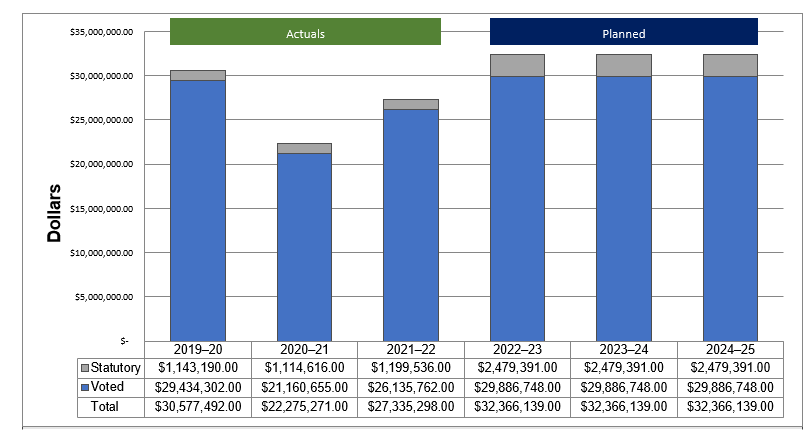
The graph illustrates POLAR’s actual and planned spending trend over a six-year period starting in 2019-20 and ending in 2024-25. The graph is based on three years of actual spending and three years of planned spending.
Due to the pandemic, total spending in 2020-21 decreased significantly when compared to 2019-20. As pandemic related restrictions were gradually lifted, spending has increased in 2021-22 and planned spending is anticipated to increase back to pre-pandemic levels 2022-23 to 2024-25.
Budgetary performance summary for core responsibilities and internal services (dollars)
The “Budgetary performance summary for core responsibilities and internal services” table presents the budgetary financial resources allocated for POLAR’s Polar Science and Knowledge Core responsibility and for internal services.
| Core responsibilities and internal services | 2021–22 Main Estimates | 2021–22 planned spending | 2022–23 planned spending | 2023–24 planned spending | 2021–22 total authorities available for use | 2019–20 actual spending (authorities used) | 2020–21 actual spending (authorities used) | 2021–22 actual spending (authorities used) |
|---|---|---|---|---|---|---|---|---|
| Polar Science and Knowledge | 16,105,186 | 16,105,186 | 16,920,422 | 16,920,422 | 16,105,186 | 15,282,156 | 9,377,632 | 13,810,911 |
| Internal services | 16,111,924 | 16,111,924 | 15,445,717 | 15,445,717 | 16,510,781 | 15,295,336 | 12,897,639 | 13,524,387 |
| Total | 32,217,110 | 32,217,110 | 32,366,139 | 32,366,139 | 32,615,967 | 30,577,492 | 22,275,271 | 27,335,298 |
Human resources
The “Human resources summary for core responsibilities and internal services” table presents the full-time equivalents (FTEs) allocated to the Polar Science and Knowledge Core Responsibility and to internal services.
Human resources summary for core responsibilities and internal services
| Core responsibilities and internal services | 2019–20 actual full-time equivalents | 2020–21 actual full-time equivalents | 2021–22 planned full-time equivalents | 2021–22 actual full-time equivalents | 2022–23 planned full-time equivalents | 2023–24 planned full-time equivalents |
|---|---|---|---|---|---|---|
| Polar science and Knowledge | 36 | 37 | 41 | 31 | 44 | 44 |
| Internal services | 42 | 42 | 50 | 41 | 51 | 51 |
| Total | 78 | 79 | 91 | 72 | 95 | 95 |
Expenditures by vote
For information on POLAR’s organizational voted and statutory expenditures, consult the Public Accounts of Canada 2021.
Government of Canada spending and activities
Information on the alignment of POLAR’s spending with Government of Canada’s spending and activities is available in GC InfoBase.
Financial statements and financial statements highlights
Financial statements
POLAR’s financial statements (unaudited) for the year ended March 31, 2022, are available on the departmental website.
Financial statement highlights
Condensed Statement of Operations (unaudited) for the year ended March 31, 2022 (dollars)
| Financial information | 2021–22 planned results | 2021–22 actual results | 2020–21 actual results | Difference (2021–22 actual results minus 2021–22 planned results) | Difference (2021–22 actual results minus 2020–21 actual results) |
|---|---|---|---|---|---|
| Total expenses | 33,055,584 | 27,434,483 | 22,677,786 | -5,621,101 | 4,756,697 |
| Total revenues | 449,211 | 276,469 | 292,040 | -172,742 | -15,571 |
| Net cost of operations before government funding and transfers | 32,606,373 | 27,158,014 | 22,385,746 | -5,448,359 | 4,772,268 |
Condensed Statement of Financial Position (unaudited) as of March 31, 2022 (dollars)
| Financial information | 2021–22 | 2020–21 | Difference(2021–22 minus 2020–21) |
|---|---|---|---|
| Total net liabilities | 3,545,698 | 2,858,447 | 687,521 |
| Total net financial assets | 3,058,137 | 2,390,470 | 667,667 |
| Departmental net debt | 487,831 | 467,977 | 19,854 |
| Total non-financial assets | 1,740,394 | 1,458,778 | 281,616 |
| Departmental net financial position | 1,252,563 | 990,801 | 261,762 |
The 2021–22 planned results information is provided in POLAR’s Future-Oriented Statement of Operations and Notes 2021–22: Future-Oriented Statement of Operations 2021-2022 - Canada.ca.
Corporate information
Organizational profile
Appropriate minister[s]: The Honourable Dan Vandal, P.C., M.P.
Institutional head: Jennifer C. Hubbard, President and Chief Executive Officer
Ministerial portfolio: Minister of Northern Affairs
Enabling instrument[s]: Canadian High Arctic Research Station Act
Year of incorporation / commencement: 2015
Other: POLAR is overseen by a nine-member Board of Directors, including a Chairperson and Vice-Chairperson. The Board approves the Agency’s science and technology plan and annual work plans and budget. The Board is accountable to the Minister of Northern Affairs. All members are appointed by Order-in-Council to hold office for terms not exceeding five years, and are eligible for re-appointment for a second term of office. Members of the Board of Directors hold office on a part-time basis.
Raison d’être, mandate and role: who we are and what we do
“Raison d’être, mandate and role: who we are and what we do” is available on POLAR’s website.
For more information on the department’s organizational mandate letter commitments, see the Minister’s mandate letter.
Operating context
Information on the operating context is available on POLAR’s website.
Reporting framework
POLAR’s Departmental Results Framework and Program Inventory of record for 2021–22 are shown below.
| Departmental Results Framework | Core Responsibility: Polar science and knowledge | Internal Services | |
| Departmental Result #1: Canada’s polar science and technology research is publicly available and being applied | Indicator #1: Percentage of research publications led or supported by Polar Knowledge Canada that are available online to the Canadian public | ||
| Indicator #2: Number of citations of research led or supported by Polar Knowledge Canada | |||
| Departmental Result #2: Canada’s Arctic science includes Indigenous and local knowledge | Indicator #1: Percentage of Arctic research projects led or supported by Polar Knowledge Canada that include Indigenous or local knowledge | ||
| Indicator #2: Percentage of Arctic projects led or supported by Polar Knowledge Canada that involve Northerners | |||
| Departmental Result #3: Canada fosters domestic and international knowledge exchange and partnerships in polar science | |||
| Indicator #1: Percentage of projects led by Polar Knowledge Canada that involve external partners | |||
| Indicator #2: Percentage of leveraged investment by Polar Knowledge Canada supported projects | |||
| Indicator #3: Number of knowledge exchange activities or initiatives led or supported by Polar Knowledge Canada | |||
| Departmental Result #4: The next generation of Canadian polar researchers is developed | Indicator #1: Percentage of Polar Knowledge Canada-led or supported projects that involve youth or early career researchers | ||
| Program Inventory | Program: Science and Technology | ||
| Program: Knowledge Management and Engagement | |||
Supporting information on the program inventory
Financial, human resources and performance information for POLAR’s Program Inventory is available in GC InfoBase.
Supplementary information tables
The following supplementary information tables are available on POLAR’s website:
- Departmental Sustainable Development Strategy/Reporting on Green Procurement
- Details on transfer payment programs
- Gender-based analysis plus
Federal tax expenditures
The tax system can be used to achieve public policy objectives through the application of special measures such as low tax rates, exemptions, deductions, deferrals and credits. The Department of Finance Canada publishes cost estimates and projections for these measures each year in the Report on Federal Tax Expenditures. This report also provides detailed background information on tax expenditures, including descriptions, objectives, historical information and references to related federal spending programs as well as evaluations and GBA Plus of tax expenditures.
Organizational contact information
Headquarters
Polar Knowledge Canada – Canadian High Arctic Research Station
1 Uvajuq Road
P.O. Box 2150
Cambridge Bay, NU, X0B 0C0
Telephone: (867) 983-7425
Ottawa Office
Polar Knowledge Canada
170 Laurier Avenue West, Suite 200
Ottawa, ON, K1P 5V5
Telephone: (613) 943-8605
Email: info@polar.gc.ca
Website(s): https://www.canada.ca/en/polar-knowledge.html
Appendix: definitions
appropriation (crédit)
Any authority of Parliament to pay money out of the Consolidated Revenue Fund.
budgetary expenditures (dépenses budgétaires)
Operating and capital expenditures; transfer payments to other levels of government, organizations or individuals; and payments to Crown corporations.
core responsibility (responsabilité essentielle)
An enduring function or role performed by a department. The intentions of the department with respect to a core responsibility are reflected in one or more related departmental results that the department seeks to contribute to or influence.
Departmental Plan (plan ministériel)
An enduring function or role performed by a department. The intentions of the department with respect to a core responsibility are reflected in one or more related departmental results that the department seeks to contribute to or influence.
departmental priority (priorité)
A plan or project that a department has chosen to focus and report on during the planning period. Priorities represent the things that are most important or what must be done first to support the achievement of the desired departmental results.
departmental result (résultat ministériel)
A consequence or outcome that a department seeks to achieve. A departmental result is often outside departments’ immediate control, but it should be influenced by program-level outcomes.
departmental result (résultat ministériel)
A consequence or outcome that a department seeks to achieve. A departmental result is often outside departments’ immediate control, but it should be influenced by program-level outcomes.
departmental result indicator (indicateur de résultat ministériel)
A quantitative measure of progress on a departmental result.
departmental results framework (cadre ministériel des résultats)
A framework that connects the department’s core responsibilities to its departmental results and departmental result indicators.
Departmental Results Report (rapport sur les résultats ministériels)
A report on a department’s actual accomplishments against the plans, priorities and expected results set out in the corresponding Departmental Plan.
experimentation (expérimentation)
The conducting of activities that seek to first explore, then test and compare the effects and impacts of policies and interventions in order to inform evidence-based decision-making, and improve outcomes for Canadians, by learning what works, for whom and in what circumstances. Experimentation is related to, but distinct from innovation (the trying of new things), because it involves a rigorous comparison of results. For example, using a new website to communicate with Canadians can be an innovation; systematically testing the new website against existing outreach tools or an old website to see which one leads to more engagement, is experimentation.
full-time equivalent (équivalent temps plein)
A measure of the extent to which an employee represents a full person-year charge against a departmental budget. For a particular position, the full-time equivalent figure is the ratio of number of hours the person actually works divided by the standard number of hours set out in the person’s collective agreement.
gender-based analysis plus (GBA Plus) (analyse comparative entre les sexes plus [ACS Plus])
An analytical tool used to support the development of responsive and inclusive policies, programs and other initiatives; and understand how factors such as sex, race, national and ethnic origin, Indigenous origin or identity, age, sexual orientation, socio-economic conditions, geography, culture and disability, impact experiences and outcomes, and can affect access to and experience of government programs.
government-wide priorities (priorités pangouvernementales)
For the purpose of the 2021–22 Departmental Results Report, government-wide priorities refers to those high-level themes outlining the government’s agenda in the 2020 Speech from the Throne, namely: Protecting Canadians from COVID-19; Helping Canadians through the pandemic; Building back better – a resiliency agenda for the middle class; The Canada we’re fighting for.
horizontal initiative (initiative horizontale)
An initiative where two or more federal organizations are given funding to pursue a shared outcome, often linked to a government priority.
non-budgetary expenditures (dépenses non budgétaires)
Net outlays and receipts related to loans, investments and advances, which change the composition of the financial assets of the Government of Canada.
performance (rendement)
What an organization did with its resources to achieve its results, how well those results compare to what the organization intended to achieve, and how well lessons learned have been identified.
performance (rendement)
What an organization did with its resources to achieve its results, how well those results compare to what the organization intended to achieve, and how well lessons learned have been identified.
performance reporting (production de rapports sur le rendement)
The process of communicating evidence-based performance information. Performance reporting supports decision making, accountability and transparency.
plan (plan)
The articulation of strategic choices, which provides information on how an organization intends to achieve its priorities and associated results. Generally, a plan will explain the logic behind the strategies chosen and tend to focus on actions that lead to the expected result.
planned spending (dépenses prévues)
For Departmental Plans and Departmental Results Reports, planned spending refers to those amounts presented in Main Estimates.
A department is expected to be aware of the authorities that it has sought and received. The determination of planned spending is a departmental responsibility, and departments must be able to defend the expenditure and accrual numbers presented in their Departmental Plans and Departmental Results Reports.
program (programme)
Individual or groups of services, activities or combinations thereof that are managed together within the department and focus on a specific set of outputs, outcomes or service levels.
program inventory (répertoire des programmes)
Identifies all the department’s programs and describes how resources are organized to contribute to the department’s core responsibilities and results.
result (résultat)
A consequence attributed, in part, to an organization, policy, program or initiative. Results are not within the control of a single organization, policy, program or initiative; instead they are within the area of the organization’s influence.
statutory expenditures (dépenses législatives)
Expenditures that Parliament has approved through legislation other than appropriation acts. The legislation sets out the purpose of the expenditures and the terms and conditions under which they may be made.
target (cible)
A measurable performance or success level that an organization, program or initiative plans to achieve within a specified time period. Targets can be either quantitative or qualitative.
voted expenditures (dépenses votées)
Expenditures that Parliament approves annually through an appropriation act. The vote wording becomes the governing conditions under which these expenditures may be made.
Endnotes
_________________________
- Data not available for these fiscal years as this indicator had not yet been established at that time.
- GC InfoBase, https://www.tbs-sct.gc.ca/ems-sgd/edb-bdd/index-eng.html#start
- GC InfoBase, https://www.tbs-sct.gc.ca/ems-sgd/edb-bdd/index-eng.html#start
- GC InfoBase, https://www.tbs-sct.gc.ca/ems-sgd/edb-bdd/index-eng.html#start
- GC InfoBase, https://www.tbs-sct.gc.ca/ems-sgd/edb-bdd/index-eng.html#start
- Public Accounts of Canadahttp://www.tpsgc-pwgsc.gc.ca/recgen/cpc-pac/index-eng.html
- GC InfoBase, https://www.tbs-sct.gc.ca/ems-sgd/edb-bdd/index-eng.html#start
- Polar Knowledge Canada’s Financial Reports, https://www.canada.ca/en/polar-knowledge/reports.html
- Canadian High Arctic Research Station Act, https://laws-lois.justice.gc.ca/eng/acts/C-17.8/page-1.html
- Polar Knowledge Canada’s Raison d’être, https://www.canada.ca/en/polar-knowledge/behindthescenes.html
- Polar Knowledge Canada’s Minister Mandate Letter, https://www.canada.ca/en/polar-knowledge/behindthescenes.htm#h2-2
- GC InfoBase, https://www.tbs-sct.gc.ca/ems-sgd/edb-bdd/index-eng.html#start
- Polar Knowledge Canada’s Supplementary Information Tables,Polar Knowledge Canada’s Supplementary Information Tables, https://www.canada.ca/en/polar-knowledge/reports/departmental-results-report-2020-2021/supplementary-information-tables-2020-2021.html
- Report on Federal Tax Expenditures, https://www.canada.ca/en/department-finance/services/publications/federal-tax-expenditures.html
- Polar Knowledge Canada’s Website, https://www.canada.ca/en/department-finance/services/publications/federal-tax-expenditures.html

